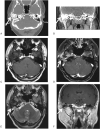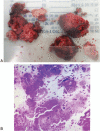Chondromyxoid fibroma of the temporal bone: A rare case report
- PMID: 32176085
- PMCID: PMC7440231
- DOI: 10.1097/MD.0000000000019487
Chondromyxoid fibroma of the temporal bone: A rare case report
Abstract
Rationale: Chondromyxoid fibroma (CMF) is a rare form of benign bone tumor and easily misdiagnosed as fibrosarcoma. Hence, to explore the clinical manifestations, diagnostic tests, and therapeutic procedures for temporal bone cartilage myxoid fibroma, it is important to optimize patient treatment and avoid overtreatment. Previous research has discussed cases of CMF, but this paper presents a systematic, complete, and comprehensive introduction of this disease based on this case and related literature.
Patient concerns: A 52-year-old male patient presented with pain in his right ear for 2 years and hearing loss in his right ear with tinnitus for 1 year. The patient had a history of hypertension for 9 years and it was well-controlled.
Diagnosis: A computed tomography (CT) scan of the temporal bone showed an expansive growth on the right temporal bone plate and tympanic plate, presenting as a cloud-like ground glass opaque shadow involving the temporom and ibular joint, middle skull base, and small auditory bones. A magnetic resonance imaging (MRI) of the temporal bone showed a large and irregular soft tissue mass shadow on the right temporal bone plate. The right temporal bone plate was occupied by the lesion, consistent with a bone origin. From the results of the imaging examination of the patient, a lesion occupying the temporal bone in the right ear and mastoiditis in the right middle ear was initially diagnosed.
Interventions: Right ear temporal bone tumor resection and abdominal fat extraction were conducted.
Outcomes: Postoperative pathological results demonstrated myxoid fibroma of the temporal bone cartilage. No recurrence or severe complications were observed in 8 months of follow-up.
Lessons: A finding of myxoid fibroma of the temporal bone cartilage is rare in the clinic. The growth of such tumors is slow. The temporal bone CT and inner ear MRI were helpful in diagnosis. Surgery was the principal treatment.
Conflict of interest statement
The authors have no conflicts of interest to disclose.
Figures





Similar articles
-
Chondromyxoid fibroma of frontal bone: a case report and review of the literature.Turk Neurosurg. 2008 Jul;18(3):249-53. Turk Neurosurg. 2008. PMID: 18814113 Review.
-
Chondromyxoid fibroma of the temporal bone.Surg Neurol. 1997 Aug;48(2):148-52. doi: 10.1016/s0090-3019(96)00462-4. Surg Neurol. 1997. PMID: 9242240 Review.
-
Chondromyxoid fibroma of the petrous-sphenoid junction.Surg Neurol. 1987 Feb;27(2):182-6. doi: 10.1016/0090-3019(87)90293-x. Surg Neurol. 1987. PMID: 3810448
-
[Retrofacial approach to remove a rare chondromyxoid fibroma of the infralabyrinthine space].Vestn Otorinolaringol. 2021;86(4):106-110. doi: 10.17116/otorino202186041106. Vestn Otorinolaringol. 2021. PMID: 34499457 Review. Russian.
-
[A giant chondromyxoid fibroma originated from the right orbital roof.--A case report--].No Shinkei Geka. 1982 Jul;10(7):731-6. No Shinkei Geka. 1982. PMID: 7133296 Japanese.
Cited by
-
Introduction of temporomandibular joint and skull base combined reconstruction by autogenous bone graft.Clin Oral Investig. 2023 Jun;27(6):2513-2520. doi: 10.1007/s00784-023-05065-4. Epub 2023 May 24. Clin Oral Investig. 2023. PMID: 37221432 Review.
-
Diagnostic challenge in chondromyxoid fibroma clinically mimicking neuroma.Contemp Oncol (Pozn). 2024;28(3):267-269. doi: 10.5114/wo.2024.144081. Epub 2024 Oct 15. Contemp Oncol (Pozn). 2024. PMID: 39512533 Free PMC article.
References
-
- Jaffe HL, Lichtenstein L. Chondromyxoid fibroma of bone; a distinctive benign tumor likely to be mistaken especially for chondrosarcoma. Arch Pathol (Chic) 1948;45:541–51. - PubMed
-
- Lingen MW, Solt DB, Polverini PJ. Unusual presentation of a chondromyxoid fibroma of the mandible. Report of a case and review of the literature. Oral Surg Oral Med Oral Pathol 1993;75:615–21. - PubMed
-
- Lang S, Adler CP. Bone diseases: macroscopic, histological and radiological diagnosis of structural changes in skeleton, Springer-Verlag, 2000, pages 589, DM 269, ISBN 3-540-65061-X. Eur J Radiol 2001;37:139.
Publication types
MeSH terms
LinkOut - more resources
Full Text Sources

